Social media marketing has revolutionized how brands connect with their audience. Gone are the days of shouting into the void, hoping your clients hear you.
Today, social media platforms create a vibrant online space where you can connect with millions worldwide. Audiences expect you to be there and act your best, while you can harness these online channels’ reach and engagement potential.
A successful social media marketing strategy can do wonders for creating a strong, loved brand, so we created a complete social media strategy workbook.
We asked 46 social media strategists or individuals in senior social media roles to share the steps they follow when developing a strategic social media plan.
Read this comprehensive article to find a social media strategy outline, a free social media strategy template, with actionable lessons and frequent mistakes to avoid.
Let’s get to work.
Track KPIs and present your plan like a pro to clients or managers.
Table of Contents
What is a social media strategy?
Why brands need a social media strategy
9 steps to create an effective social media strategy
Social media strategy template
Social media strategy mistakes
Who’s responsible for creating a social media strategy plan?
How often you should update your social media strategy
FAQs about social media strategy
What is a social media strategy?
A social media strategy is a detailed blueprint outlining a brand's approach to using social platforms to achieve marketing objectives such as brand awareness, lead generation, or sales.
It involves identifying target audiences, determining the most suitable social channels, creating a social media plan with different themes and formats, and publishing consistently.
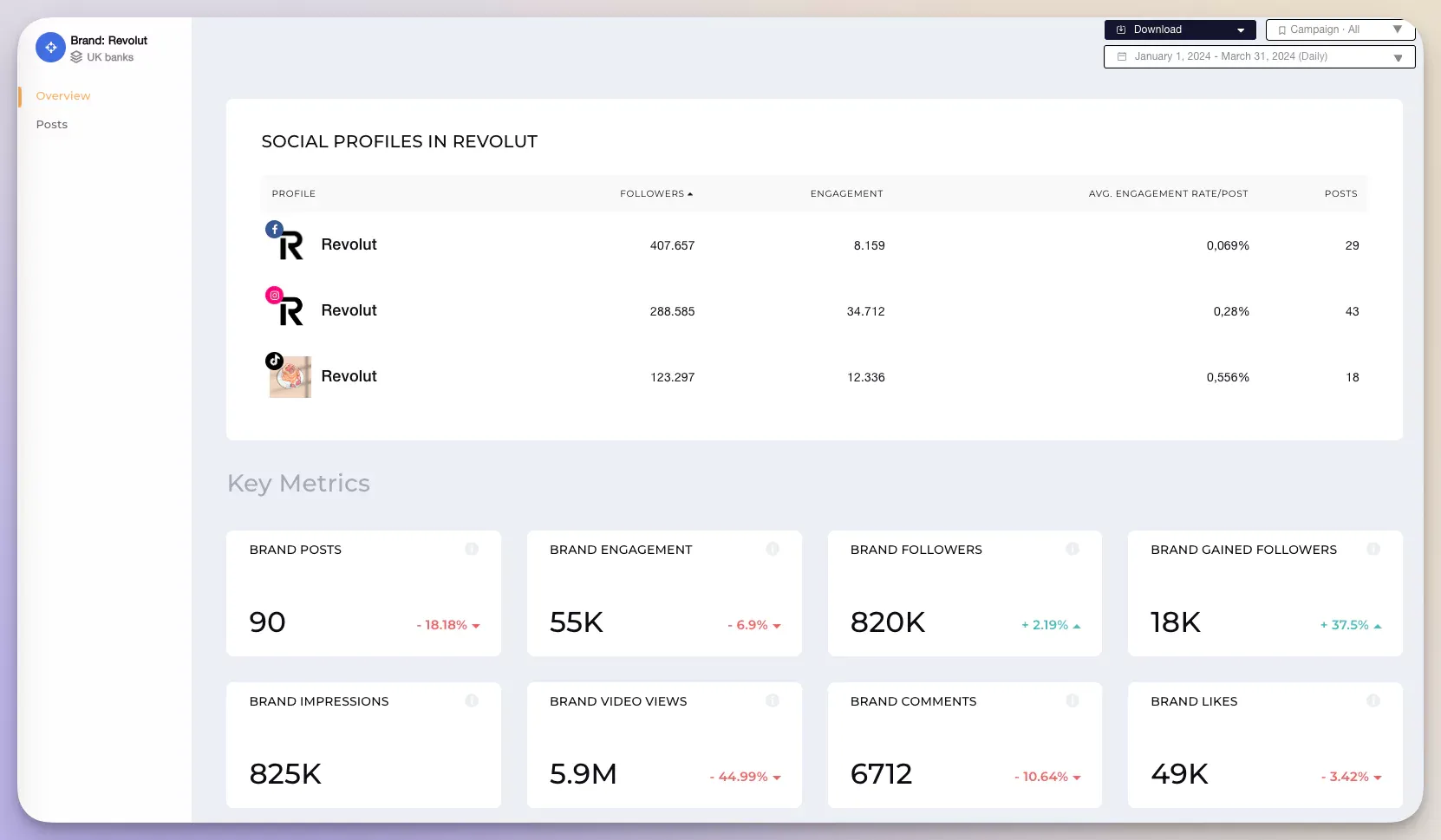
Get strategic insights with Socialinsider
Social media audits. Competitor analysis. Historical posts data. Track and measure social media performance.
Why brands need a social media strategy
Simply put, nowadays, businesses cannot afford not to have a social media strategy plan.
Marketing on social media allows you to directly address your audience, sparking engagement and fostering connections in a way that wasn't possible in the past.
You can authentically share your brand story and get real-time feedback from your prospects and customers. Their responses, opinions, and questions provide invaluable insights that can help you refine your products and brand message and create more efficient marketing campaigns.
Social channels are great places to build and nurture communities around brands, improving loyalty and boosting word-of-mouth marketing.
Not least, social media channels such as Instagram or TikTok are increasingly being used as an alternative to search engines, so optimizing your social media pages and posts can result in a better reach and more potential clients.
To get all the benefits of successful social media planning, you must create a well-defined strategy that will enable you to achieve the following:
Focus and relevance
A social media content strategy ensures that you consistently focus on the most relevant channels and types of content for your audience.
Better budget and resource allocation
The world of social media is abundant with opportunities, but a lack of strategy can result in scattered efforts. A social strategy helps you plan months ahead, organize activities to ensure proper executions, and decide where the money is best spent.
Enhanced brand identity
A social media marketing strategy helps build a recognizable brand voice that resonates with your target audience and helps you stand out.
Measurable results
With a strategy in place, you can track and analyze key metrics to evaluate the effectiveness of your social media efforts, enabling data-driven decision-making and continuous improvement.
Better customer experience
Feedback and audience insights allow you to personalize your communication, improving customer service and satisfaction. After all, 76% of consumers appreciate when businesses prioritize customer support on social media.
9 steps to create an effective social media strategy
1. Discovery phase: business objectives and brand identity
2. Understand the target audience
3. Perform a social media audit
4. Analyze competitors
5. Set SMART social media goals and track them
6. Choose the most relevant social media channels
7. Create a social media content strategy
8. Use strategic social media paid campaigns to boost reach and conversions
9. Test, evaluate, and optimize your social media strategy
Creating a strategy for social media marketing from scratch is challenging. It will test your creativity and marketing knowledge, but the result is worth it.
The good news? You don't need to be a marketing guru to know how to develop a social media strategy. In fact, we reached out to several social media seasoned experts to bring you valuable tips that you can immediately apply to your audience and needs.
Follow the strategic social media marketing steps below and you will soon be the proud owner of a winning marketing strategy for social media that fuels your brand's success.
#1. Discovery phase: business objectives and brand identity
For a successful social media strategy that drives long-term results, initial research is essential. Start by clearly understanding the brand identity and overall business objectives.
The foundation of any successful social media strategy begins with thorough research.
This involves diving deep into understanding the brand, its audience, and the broader industry," says Ivy Mullins, Social Media Manager at Born Social
The discovery phase means gathering and analyzing critical data to create a comprehensive picture of where the brand stands and is headed. It helps you identify both strong areas and gaps that need mending.
My typical social media strategy process begins with an analysis of the brand's current position, target audience, and overall business goals. - Cory Williams, Head of Social Media & Influencer Marketing at Handshake
To go through this phase effectively, you should approach multiple stakeholders and departments within the company.
This involves collaborating with various teams beyond just social e.g., analytics, CRM, search, creative, and influencer marketing, to gather as much existing data as possible.
I also identify and consult key stakeholders to understand brand performance across all digital channels. - Kineta Kelsall, Founder & Director School of Social
With this approach, you can get a holistic view of the brand's performance across digital channels and find opportunities for improvement.
Equally important in the discovery process is understanding the brand itself. Get your metaphorical teeth into its mission, values, and identity. Conduct interviews with key stakeholders, including founders or business owners, as they can best explain the core elements that define the brand.
"90-minute interview with founder or business owner" is Dorien Morin-van Dam's advice - Organic Social Media Strategist at More in Media
These first-hand accounts are important for creating a social media strategy outline that authentically represents the brand's voice and resonates with the target audience.
The ultimate goal of this phase is to ensure that your social media strategy is not only aligned with the business objectives but also reflects the brand's unique voice in an appealing way.
When developing a social media strategy, I begin by understanding the brand's identity, mission, values, and target audience.
This involves analyzing existing social media content, brand guidelines, and conducting interviews with key stakeholders. - Essence Smith, Head of Social Media at Ascendion
But don't stop at the brand's core identity and business goals. Analyze existing content, review engagement metrics, and benchmark performance against competitors. More on this in the following steps.
#2. Understand your target audience
Imagine organizing a birthday party, but instead of gathering family and friends, you pass around invitations to everyone you can find. You might get a lively crowd, but would it be enjoyable? Probably not.
The same goes for social media marketing for business. Without knowing your target audience, your content might be great, but it won't resonate with the right people.
When developing a social media strategy, I start by conducting in-depth research to understand the brand, its target audience, and competitors.
This ensures that the strategy is rooted in a deep understanding of the market and can effectively resonate with the intended audience. - Alma Pantaloukas, Founder + Lead Strategist at Ritual Thrive
Defining your target audience is crucial in creating a social media strategy because it will help you focus and attract people who care about your business.
Social media strategy should be approached like any other type of strategy, and that starts with research.
Research needs to be centered around the target audience, understanding audience profiles, user behaviors, and drivers, and their affinities to uncover how your brand can be relatable for them - agrees Vivian Huang, Strategy Director at Monks
Here's what to research:
- Job title: What sort of job titles does this persona have?
- Demographics: Age, gender, location, income, and education level.
- Interests: Hobbies, passions, preferred brands and products.
- Social media habits: Preferred platforms, topics they engage with, and frequency of use.
- Online communities: Forums and groups relevant to your audience.
- Brand affinities: Which brands do they already interact with or admire on social media?
- Budget for your product/service: What do you know about how much they are willing or able to spend in your category?
- Goals/aspirations: What do they aim for in life, and how does your brand support them?
- Pain points: Problems they face and challenges they need help addressing.
- How we help: How does your product/service solve their challenge?
I conduct a thorough audit of the brand, its audience, the market, and the cultural landscape relevant to the client's industry.
Only after this in-depth research and analysis do I develop a strategic plan. - Kineta Kelsall, Founder & Director School of Social
With this information, you can create a list of themes and topics, choose the right platforms and content formats, identify relevant conversations to join, decide on a posting schedule, and refine your tone of voice.
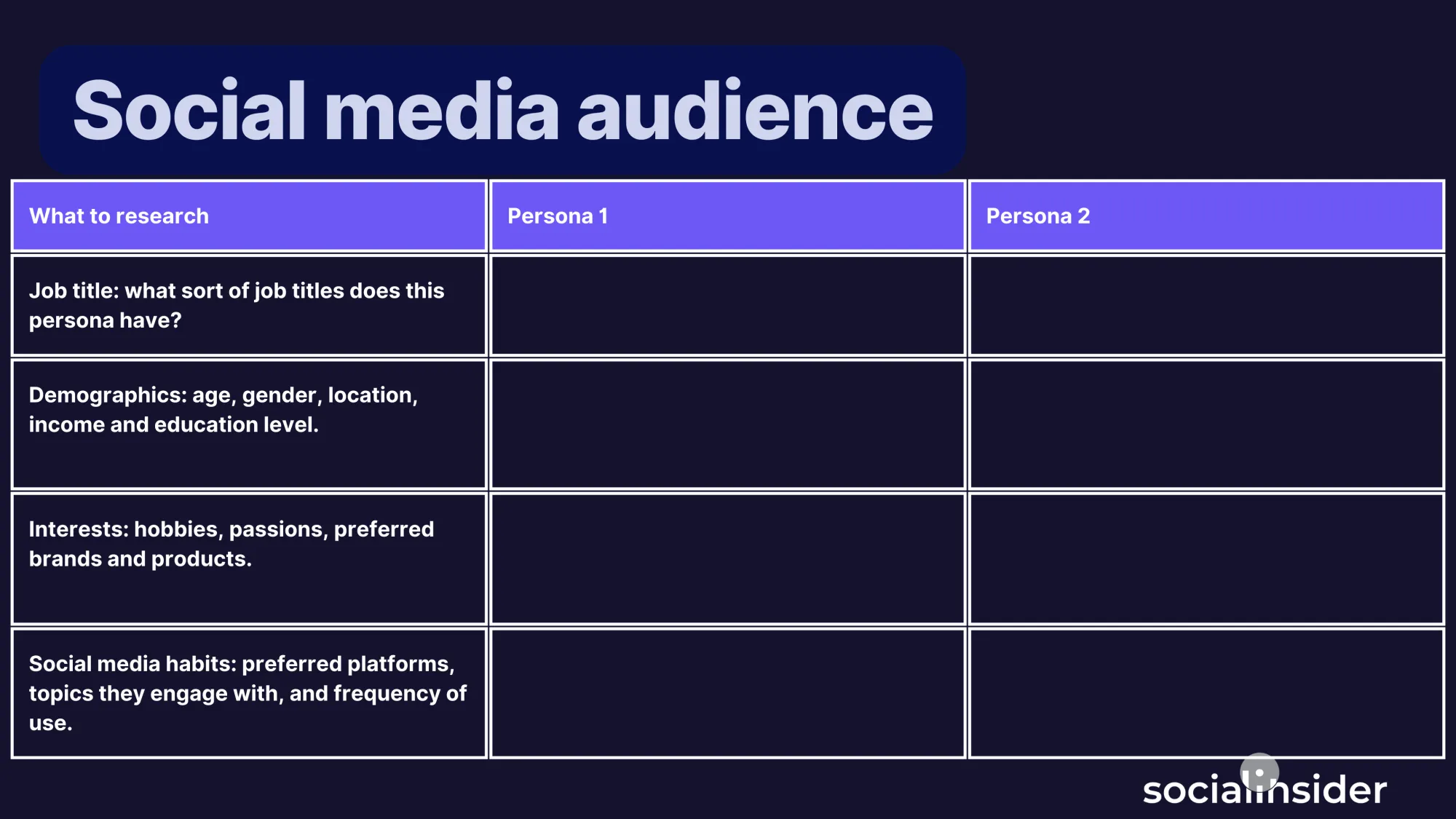
If you're not familiar with audience research, here are the sources that will help you fill in the blanks:
- Existing customer insights can come from your own surveys or data available on social media analytics platforms. Socialinsider helps brands better understand their audience by offering comprehensive reports of followers’ profiles, as in the example below.
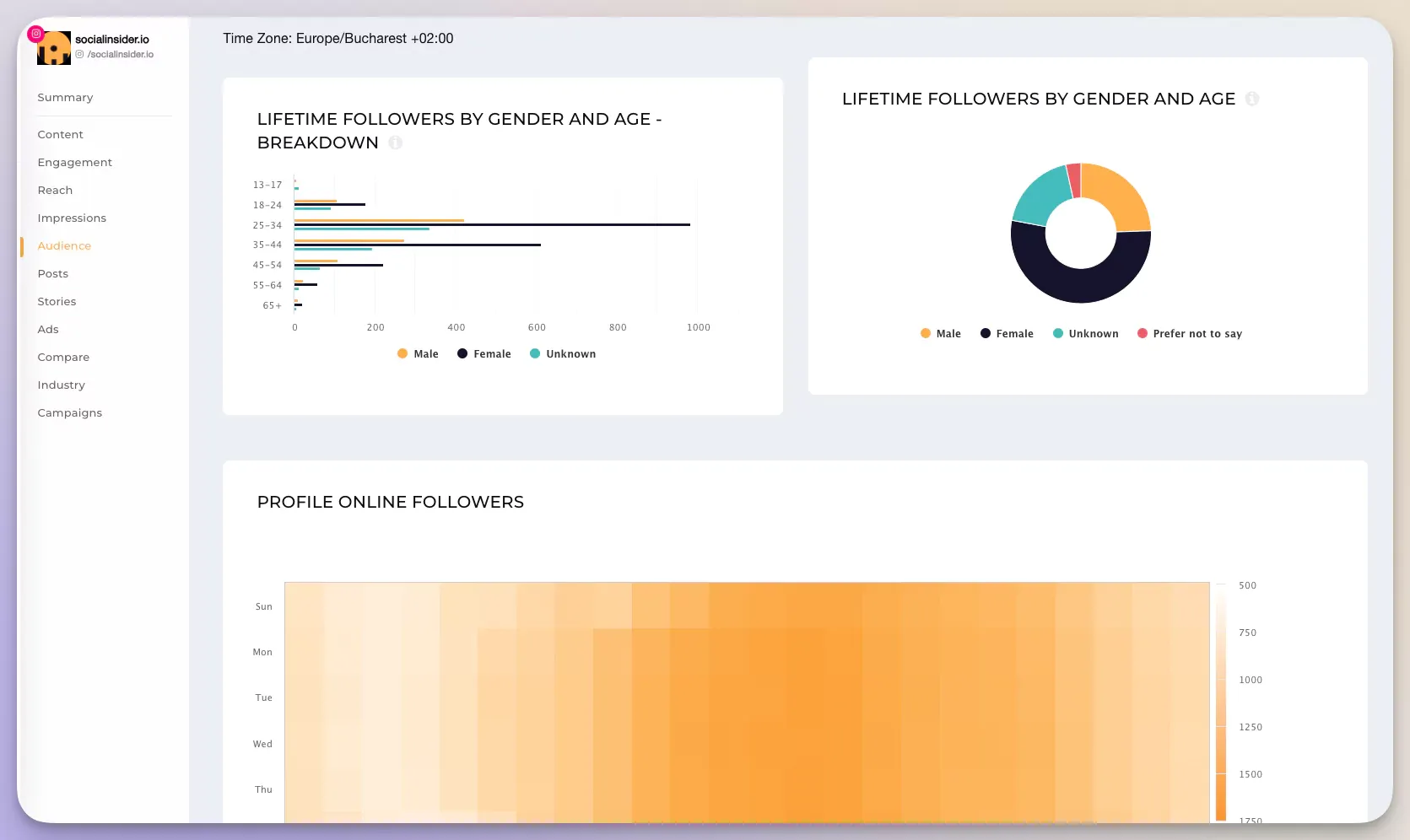
- Competitor analysis into who similar brands target on social media and who their followers are.
- Social listening to better understand online behavior and identify topics of conversation among your clients.
- Industry reports and research studies that offer insights into your target audience's behavior and online habits.
- Brand audits to access quantitative and qualitative data on how your audience perceives your brand.
- Cross-channel analysis to understand which channels your audience is most active on and where you can find different demographics.
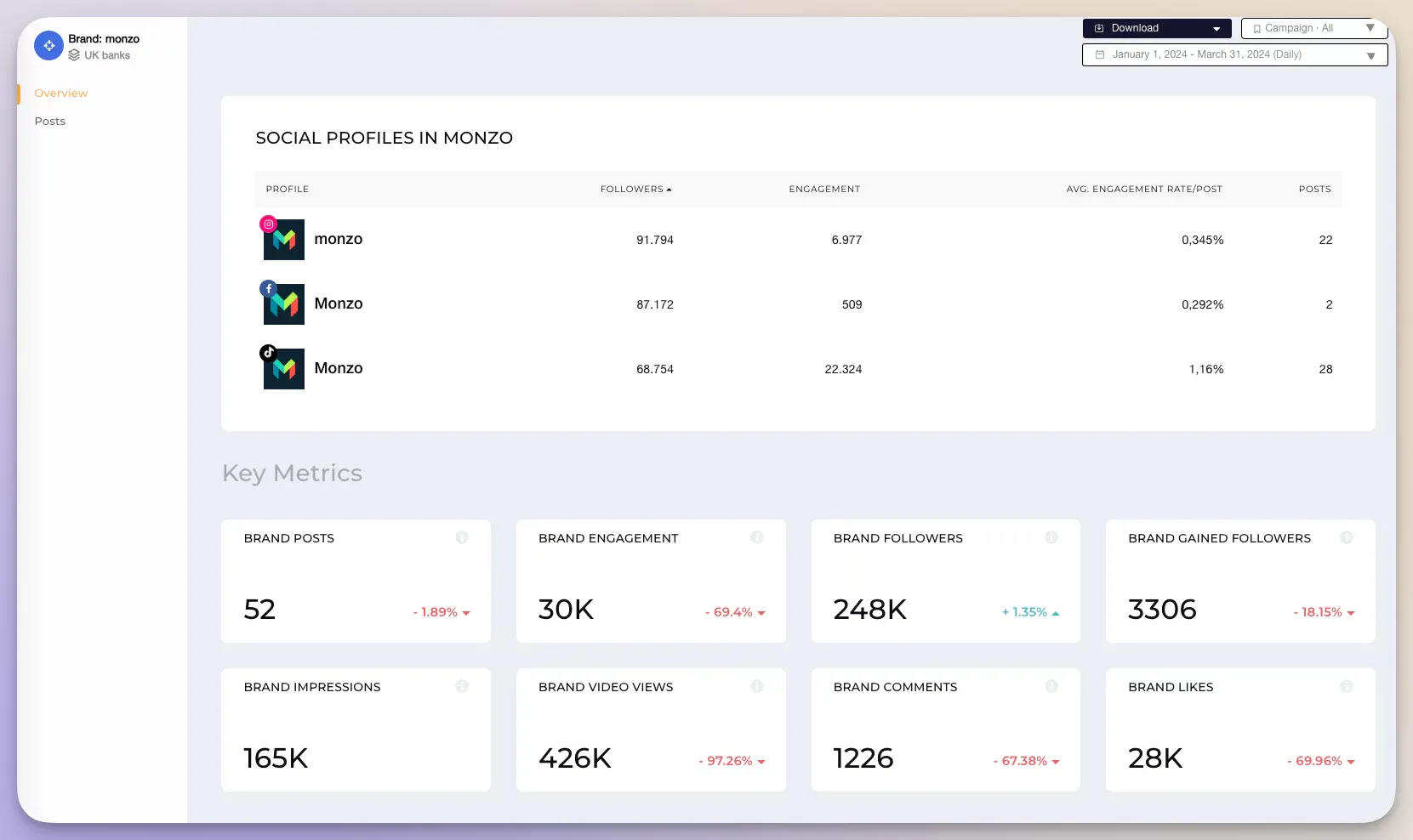
Combining these methods allows you to create a detailed profile of your ideal social media audience.
Remember that your target audience can evolve, so regular research and monitoring are essential to keep your social strategy current.
#3. Perform a social media audit
If you’re already present on social media, it’s important to take a good look at your pages, analyze past performance, understand what has been working, and where your resources might be wasted.
Next, I conduct a social media audit to assess the brand's current presence, including follower count, engagement rates, and competitor analysis.
This helps identify strengths, weaknesses, and opportunities for improvement. - Essence Smith, Head of Social Media at Ascendion
A social media audit provides crucial information to build a stronger social media strategy.
Here's how it helps:
- Understand what’s working and what’s not. Identify areas where your social media presence is thriving and areas that need improvement.
In this phase, I take the time to really understand what has been done, the status, where the brand stands against its competitors, and what some of the opportunity areas are.
Ask other teammates about the previous strategy and where they have seen success with social. - Juliana Degli, Senior Social Media Strategist at RootstockLabs
- Analyze KPIs. Metrics like engagement rate, follower growth, reach, and content performance to understand what resonates and what doesn't with your audience.
- Check alignment with marketing goals. An audit helps you evaluate whether your content promotes brand awareness, gets leads, or promotes sales — depending on your goals. If there's a disconnect, your new social media strategy can correct that.
- Get audience insights. Look into who your current followers are, what content they interact with, and where they might be located. Check whether you're reaching the right buyer persona or if your strategy should course correct.
- Conduct social listening. Track brand mentions, identify trends and emerging topics, understand customer sentiment, and gain valuable insights into your target audience's behavior and preferences.
A social media audit from the previous period (quarterly, half year, or full year) should also include insights from social listening. - Amanda Midence, Social Media Strategist at Radboud University
- Find growth opportunities. Maybe you need to pay more attention to a platform where your target audience is highly active or a type of content that generates high engagement. A social media audit can uncover these gaps, allowing you to explore new tactics.
- Create a list of actionable steps. Based on the information gathered in the previous steps, make a list of actions that you can implement to improve your social media presence. Include these in your strategy, track changes, and measure results.
Here is an audit template for your social media strategy per channel:
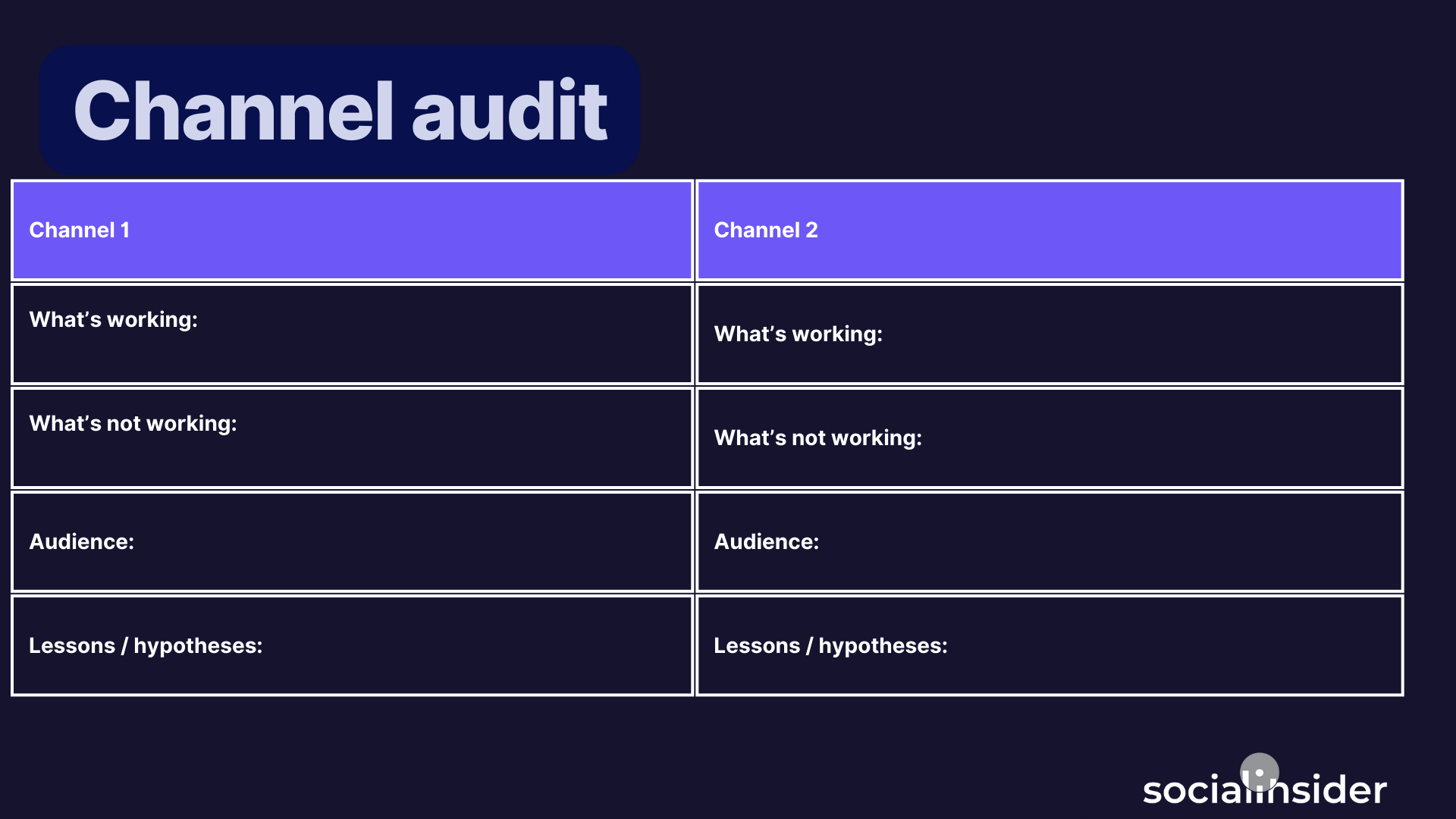
#4. Analyze competitors
In her book The Extended Mind, Annie Murphy Paul explains that although we live in times where originality is praised, imitation is the winning strategy.
By looking at how your competitors have achieved success and adapted their digital marketing strategy, you can learn and make your life much easier.
That's why competitor analysis is so valuable. It's not about copying what others do but seeing what works and what doesn’t and applying only the relevant insights to your strategy.
Beyond internal performance, studying competitors is essential. This involves evaluating their content strategies, strengths, weaknesses, and engagement tactics.
By understanding what competitors are doing well (and where they’re falling short), you can spot opportunities to differentiate your brand and outshine others in the industry. - Ivy Mullins, Social Media Manager at Born Social
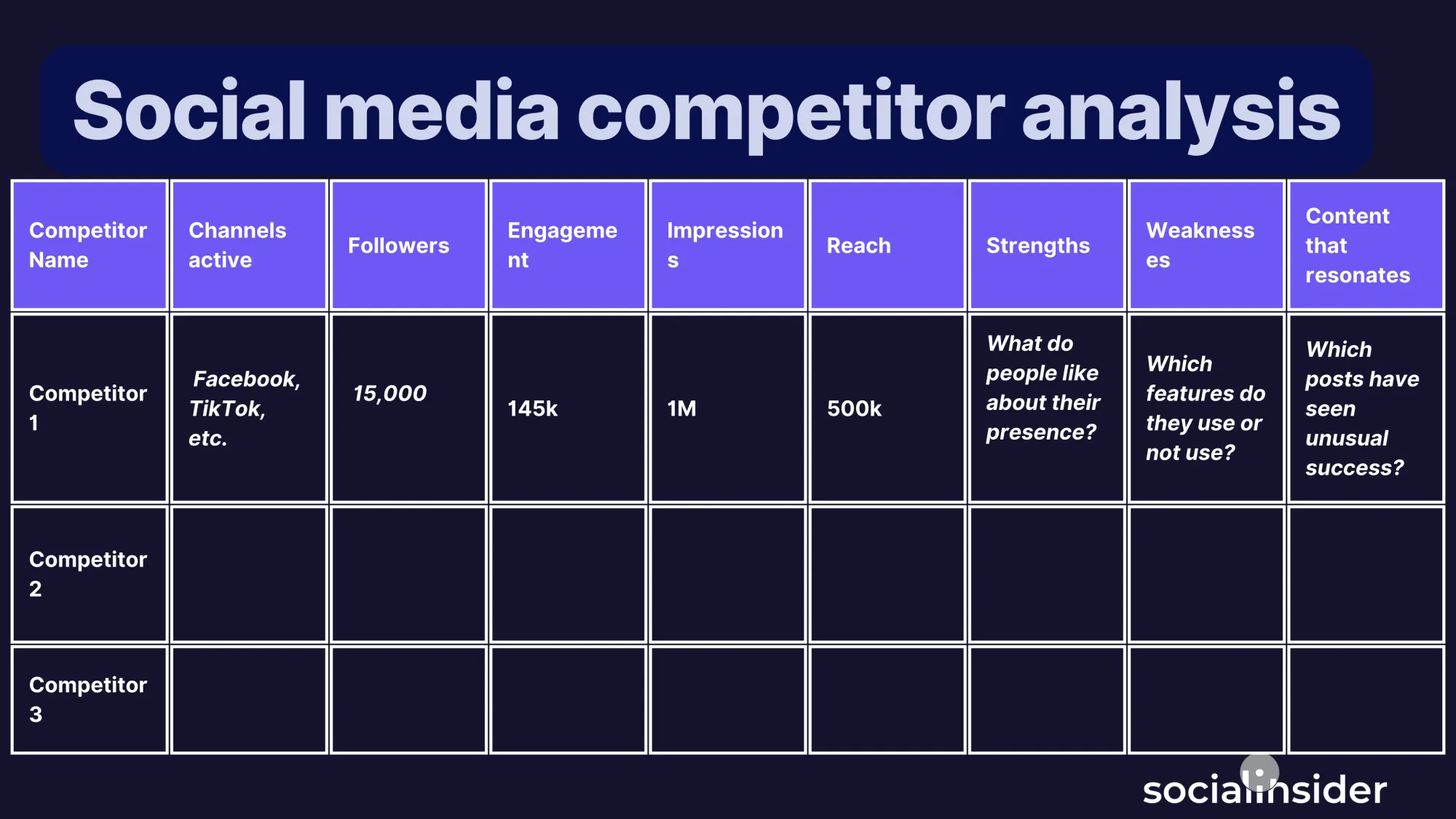
Social media competitor analysis is useful for audience research, as mentioned above, but much more than that:
- Get insights into content topics that do well with your target audience.
- Observe what social media channels your clients prefer.
- Understand what formats get the most engagement.
- Gather the most relevant hashtags to help your content perform organically.
- Make a list of relevant influencers for your industry.
- Identify content gaps in competitors' strategies and use them as opportunities to stand out.
Take a look at your competitors, both your direct and indirect ones. What are they doing to get engagement?
Can you replicate what they're doing but in your own way? - Jenny Bernarde, Social and Community Manager at BrightLocal
Conduct a SWOT analysis to highlight an overview of your competitors’ social media plan.
You need to take the information you learn in your data collection and competitor analysis to create actionable ways to improve the social media presence. - Alex Haider, Social Media Specialist at Second Harvest Heartland
This data is invaluable for social media managers looking to create an impactful strategy. Instead of starting from scratch, you get to see a social media plan example in action. Get ideas, insights, and practical data to inform your decisions.
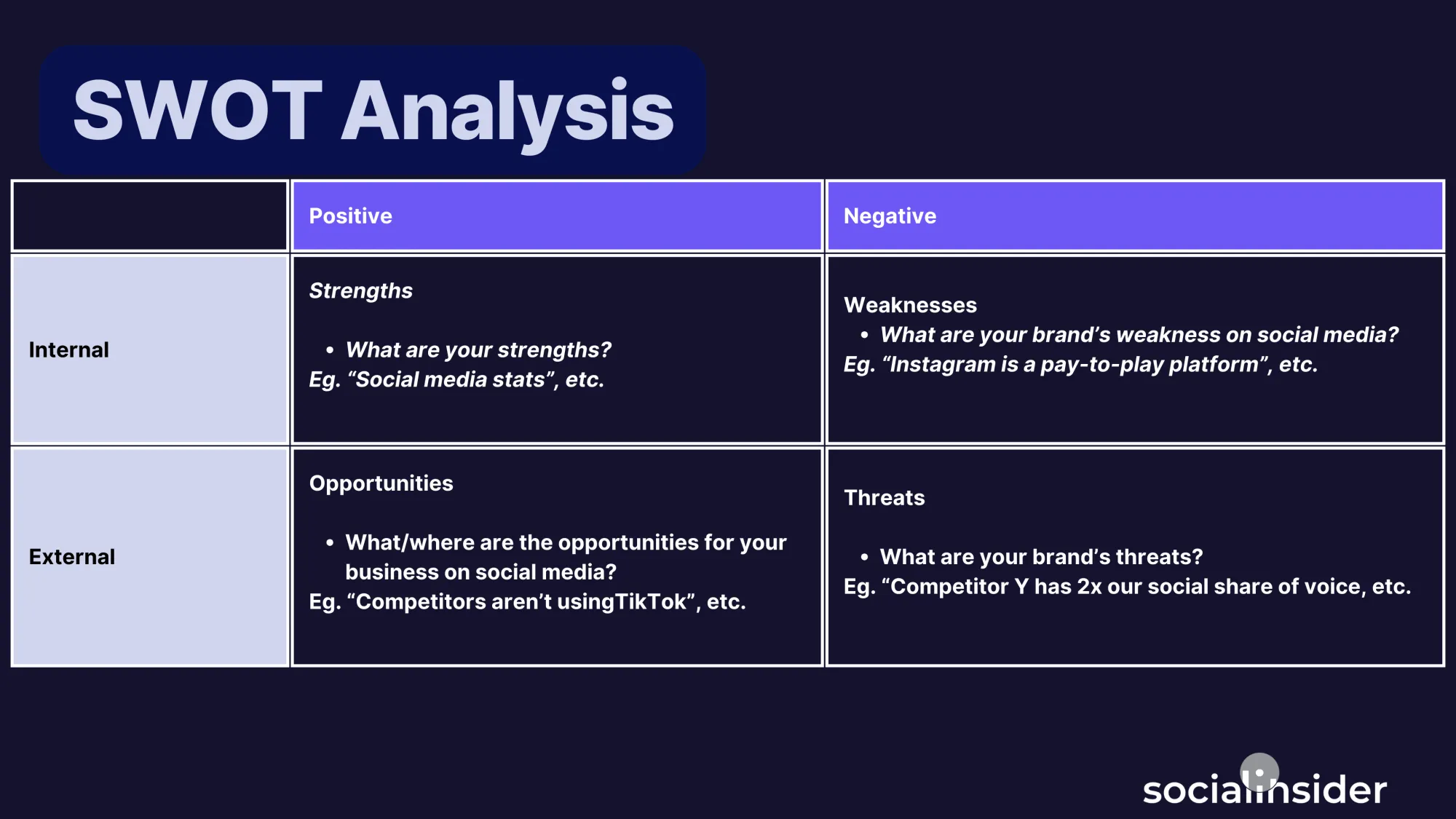
#5. Set SMART social media goals and track them
Time to focus on and define your social media goals and the right metrics to sustain them.
When crafting a social media strategy, I start by setting clear goals to know exactly what we’re aiming for. - Adriana Castillo, Product Evaluator at Phia
Social media goals should align with your business objectives, support your overall marketing strategy, and ultimately help you sell more products and services.
To be effective, they should also be SMART: specific, measurable, achievable, relevant, and time-bound.

Here are a few examples of SMART goals for social media strategies:
- Build brand awareness by achieving a 10% increase in the first quarter of 2024.
- Increase customer satisfaction by responding to all inquiries on social media within 24 hours.
- Generate 20 qualified leads per month through social media campaigns.
- Boost online sales by 15% through social media promotions by the end of the second quarter of 2024.
- Improve engagement on social media posts by 20% within four weeks.
- Increase the number of positive social media mentions of the brand by 10% in the next two months to improve brand sentiment.
- Implement a social media analytics tool to track key metrics and efficiently measure success by the end of the month.
Setting SMART goals will ensure that you are moving in the right direction and that everyone can access the same roadmap.
Whether it’s brand awareness, engagement, conversions, or community growth, I always ensure the social media goals align with overall business objectives. - Zaina Madain, Social Media at Peacock

While defining several goals when starting is tempting, remember that too many objectives can create more confusion than clarity.
Identify your primary objective and build your plan around achieving it. Break down your main goal into smaller, measurable milestones to track progress and optimize when necessary.
If your resources allow it, define one or two secondary objectives and plan for their execution.
When you're just starting with social media planning, focus on doing one thing right and gradually adding to the complexity of the strategy. For example, your primary objective can be to build brand awareness, so you will have to find the social channels preferred by your audience to grow a following.
And don’t forget to be flexible and adapt your goals in time.
A successful social media strategy requires flexibility and adaptability. As social media evolves, it's important to continuously adjust to ensure it remains aligned with your business goals. - Essence Smith, Head of Social Media at Ascendion
#6. Choose the most relevant social media channels
What is the best social media platform? It depends.
There's no single "best" platform, but the one that best fits your needs. The key is choosing channels where your target audience is already actively engaged and tailoring your content strategy to each platform's strengths.
Part of a successful strategy is understanding where to focus time and effort.
Once you have an understanding of where your audience is, then it's identifying what they want and how they want it.
For more established brands, they'll have data showing the types of products and content that typically perform better. - Dave Trausneck, Communications & Marketing Executive at Knowledge Partners
Before you include a platform in your strategy, understand if it's a good fit for your brand.
Here's a quick guide to some popular platforms and their strengths:
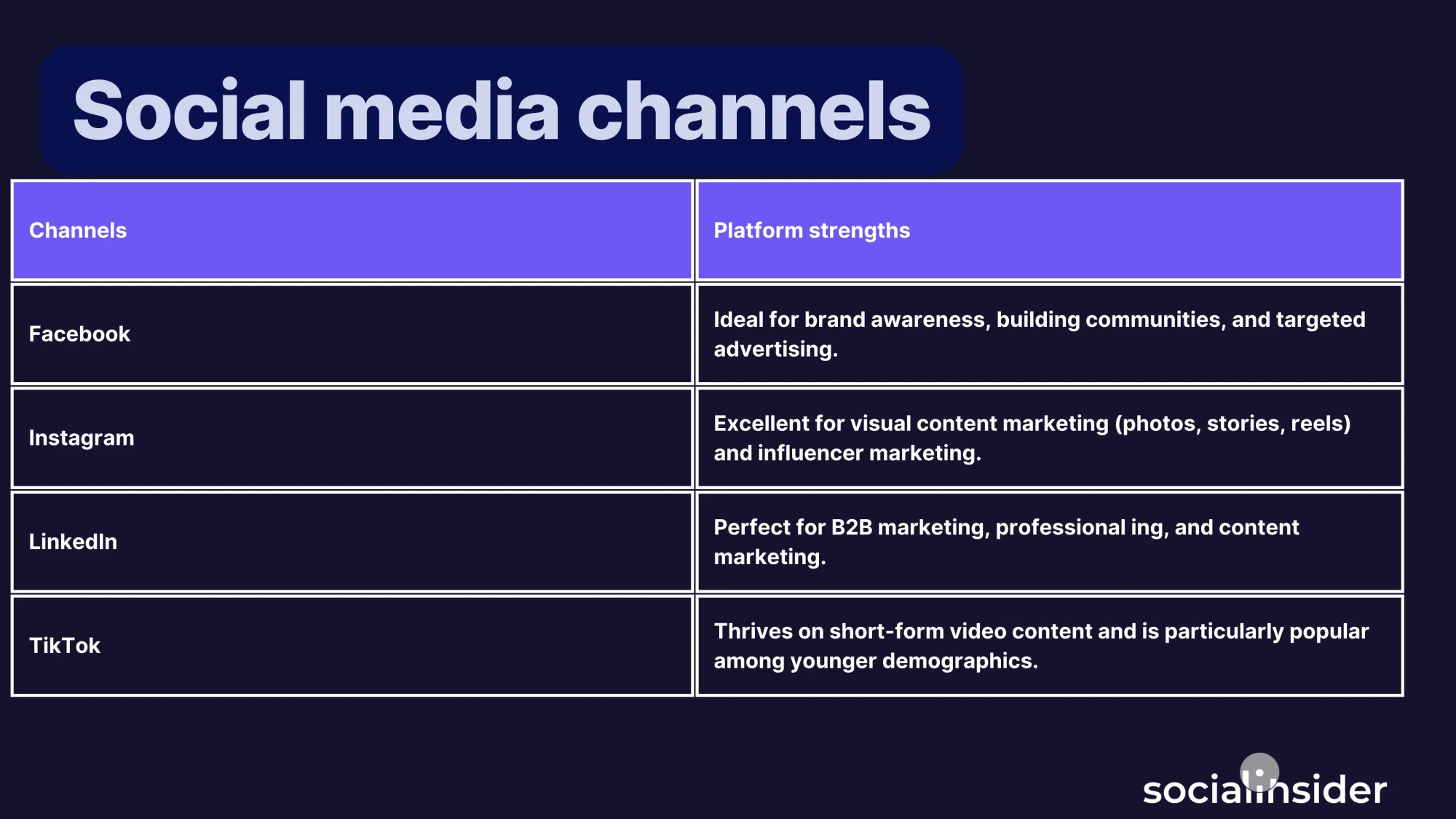
- Facebook: Ideal for brand awareness, building communities, and targeted advertising. While used by all age groups, it's most popular among males aged 25 to 34.
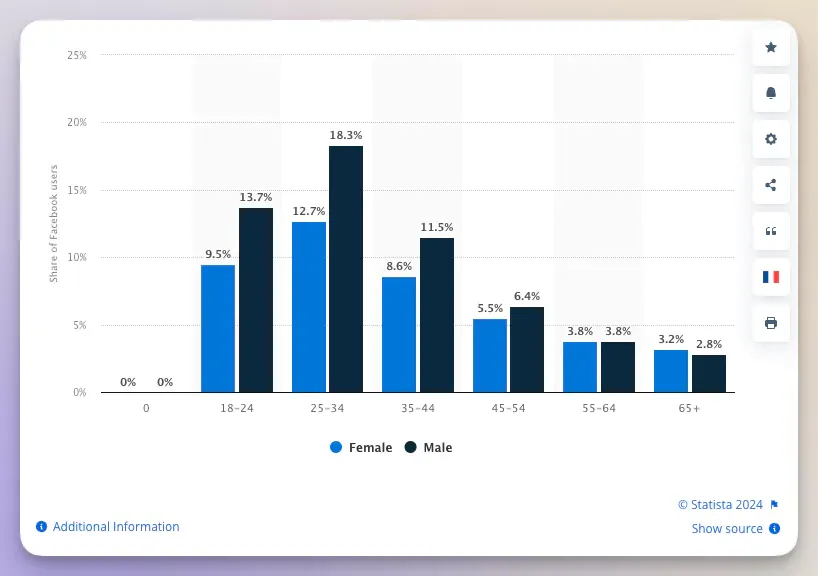
- Instagram: Excellent for visual content marketing (photos, stories, reels) and influencer marketing. Try Socialinsider's advanced AI Instagram listening to get in-depth Instagram metrics that will offer you a competitive edge.
- X (Twitter): Great for real-time updates, customer service, and thought leadership. While used globally, it's most popular in the North America, East Asia, and Southeast Asia regions.
- LinkedIn: Perfect for B2B marketing, professional networking, and content marketing.
- TikTok: Thrives on short-form video content and is particularly popular among younger demographics (Gen Z and Millennials). It aligns with a casual and fun brand voice.
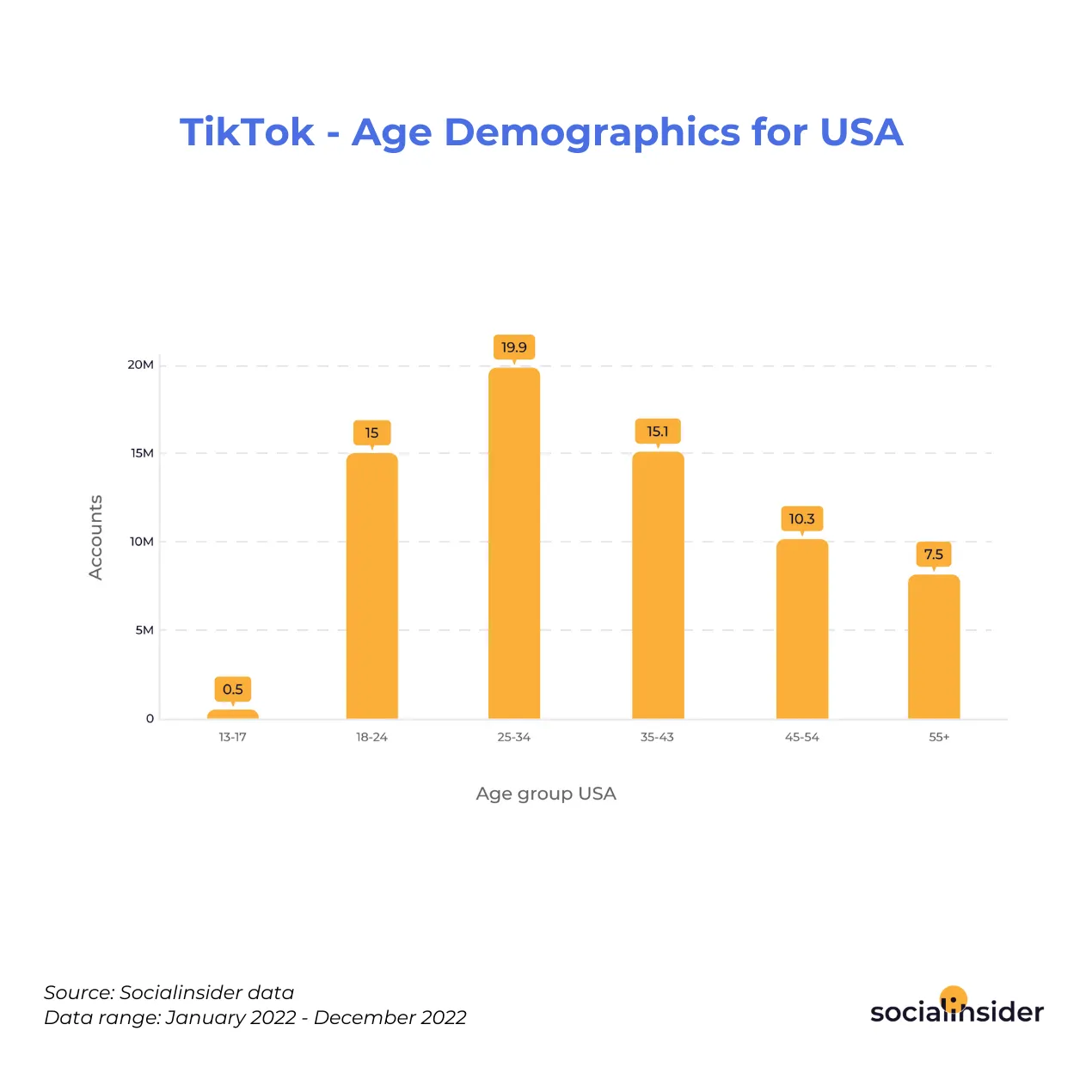
Choose one or more platforms for your social media marketing plan, but don't chase all. Few brands have the resources or the need to create content for all channels.
Look at which channels are working better than others, and figure out where your audience is. Are they on your most engaged channels? - Jenny Bernarde, Social and Community Manager at BrightLocal
Where some social media strategies go wrong is publishing the same content everywhere. To be effective, you must adapt each platform's content type and format.
So, focus on communicating with impact on one platform at a time.
For channel specific data, you can also explore Instagram Benchmarks, TikTok Benchmarks and LinkedIn Benchmarks.
#7. Create a social media content strategy
Content is not king, but the president elected by popular vote of your social media presence.
Creating relevant, useful, and engaging social media content is a must if you want to achieve any of the SMART objectives you formulated at the beginning of the process.
Once we have a general understanding of the platform strategy, we'll develop the content strategy to ensure we're always laddering back up to our north star.
If brand voice and tone aren't established already - that's a key factor to ensure the brand is showing up consistently across all marketing and social touch points. - Cory Williams, Head of Social Media & Influencer Marketing at Handshake
Let’s look at how to put together a successful social media content strategy.
Conduct a content pillars analysis
Content pillars are the main themes that guide your social media content creation. Formulate pillars taking into account three important ingredients:
- Brand objectives. Your social media content should support your business goals, so it's important to create posts that align with your overall brand direction and messaging.
- Audience needs and interests. Research topics that are relevant and important to your target audience because they are the most likely to get their attention and generate engagement.
- Competitor analysis. Examine competitors' social media presences to identify their content pillars and observe performance. Fill in gaps in your own plan or refine your strategy based on what’s producing the best results.
At the intersection of these three factors, you will find your ideal content pillars to include in your social media content strategy.
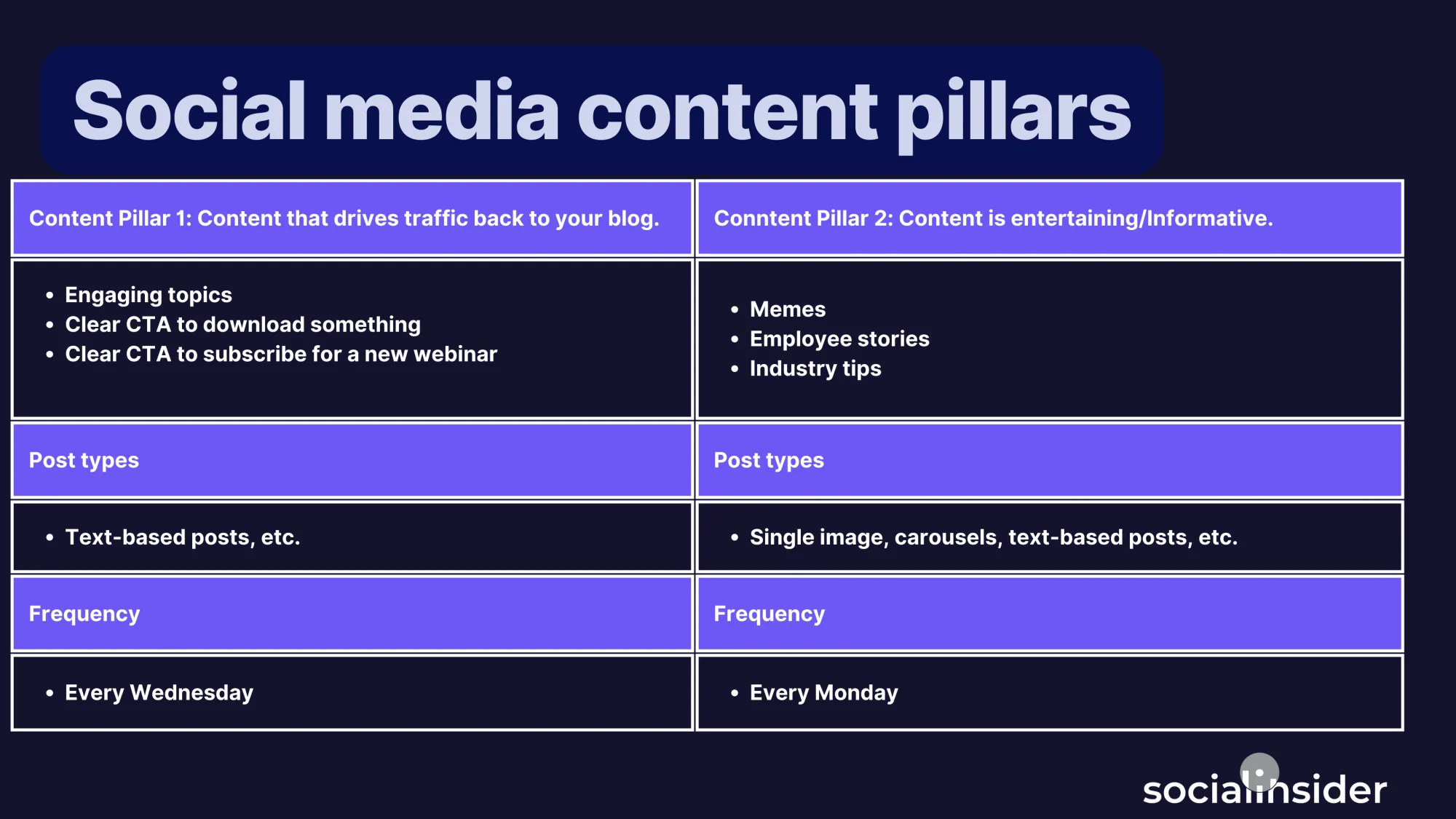
Organize a social media content calendar
Now comes the creative part! Brainstorm content ideas that resonate with your audience and support your content pillars.
A few content types to consider:
- Informative: industry insights, educational tips, tutorials, and answers to frequently asked questions.
- Engaging: questions, contests, user-generated content (UGC), and live Q&A sessions.
- Entertaining: memes, employee stories, and behind-the-scenes glimpses.
- Promotional: new product highlights, customer testimonials, offers, and exclusive discounts.
With your content pillars and themes in mind, create a social media content calendar that maps out the type of posts, platforms, publishing frequency, hashtags to use, resources needed, etc.
Below is an example of a social media plan that you can adapt for your brand.
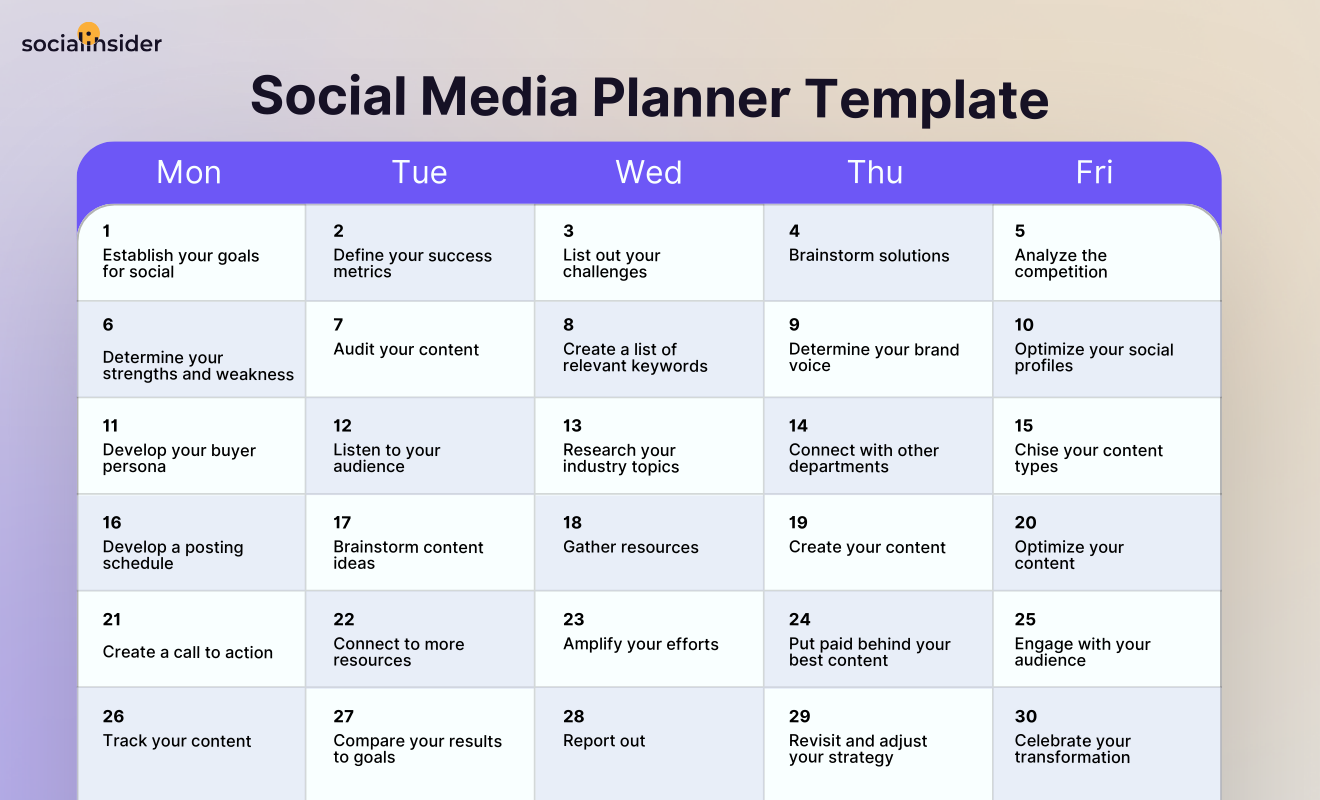
To keep your audience engaged, include a mix of content formats. These could be images, videos, infographics, blog posts, polls, UGC, etc.
Create high-quality social media posts
We’ve spent a lot of time creating the right framework for your content and ensuring that you have all the information to be relevant to the right people.
It’s time to fill in the content calendar with social media posts that will help your brand shine.
Here are a few best practices to keep in mind to craft memorable social media content:
- Focus on creating valuable content that addresses your target audience’s pain points, interests, and questions.
- Have an authentic and recognizable voice by using your brand personality and values.
- Leverage storytelling techniques to create compelling social media content.
Crafting a compelling narrative is key. While some may argue that storytelling is overused, I believe it remains a powerful tool when done authentically. I focus on messaging that is not only engaging but also consistent with the brand’s voice and values. - Zaina Madain, Social Media at Peacock
- Mix informative posts (such as educational tips, industry insights, and trends) with engaging content (such as questions, polls, or UGC) to keep your audience interested.
- Use high-quality visuals that complement your content and brand identity.
- Use clear and concise CTAs that encourage people to interact with your content: Read more, Discover offer, Share your thoughts.
By understanding your audience and constantly creating content that resonates with their needs while staying true to your brand, you’ll achieve your social media goals.
#8. Use strategic social media paid campaigns to boost reach and conversions
Social media ads can be a powerful tool for accelerating growth and more effectively reaching objectives, so make sure to include them in your strategy.
Strategically boost posts to significantly increase your visibility to a broader audience within your ideal demographics.
After developing a content calendar, I implement data-driven advertising strategies and continually monitor performance metrics.
I make real-time adjustments to optimize engagement, conversion rates, and ROI, ensuring the strategy remains flexible and results-driven. - Ammad Sattar, Digital Advertising Expert
You can also create targeted campaigns customized for your specific goals, such as driving website traffic, sparking interest in new products, and capturing leads.
Social media is also great for generating more sales. 76% of users have bought something they saw on social media, according to Forbes.
While highly effective, social media ads can quickly eat at your budget, so be sure to invest wisely:
- Target the right audience.
- Use high-quality images or videos.
- Write a clear and catchy headline.
- Write benefit-driven copy.
- Include a strong CTA.
- A/B test different variations
- Analyze results and improve campaigns.
Use both organic and paid strategies strategically to get the most out of your social media strategy.
Organic social take the lead in deciding what they want to talk about but will use blog content and take inspiration from what's coming up in email marketing so that some elements of the content are aligned.
Paid social use the data from our most popular products and use this to create ads about those / aimed at people who are more likely to buy. - Stephen Hinde, Social Media Manager at Markerstudy Group
#9. Test, evaluate, and optimize your social media strategy
Leverage social media analytics tools to gain insights into how effective social media marketing efforts are.
This final step is crucial, as experts agree.
Without data, you’re driving blind, making U-turns without knowing if you’re actually lost. Tracking performance ensures you stay on course, adjusting your strategy as needed to reach your destination—success. - Mariam Sow, Content Marketing & Social Media Strategist
Measure and track your social media performance
Track key metrics like reach, engagement, click-through rates, and follower growth. These metrics clearly show what's working and what areas need adjustment.
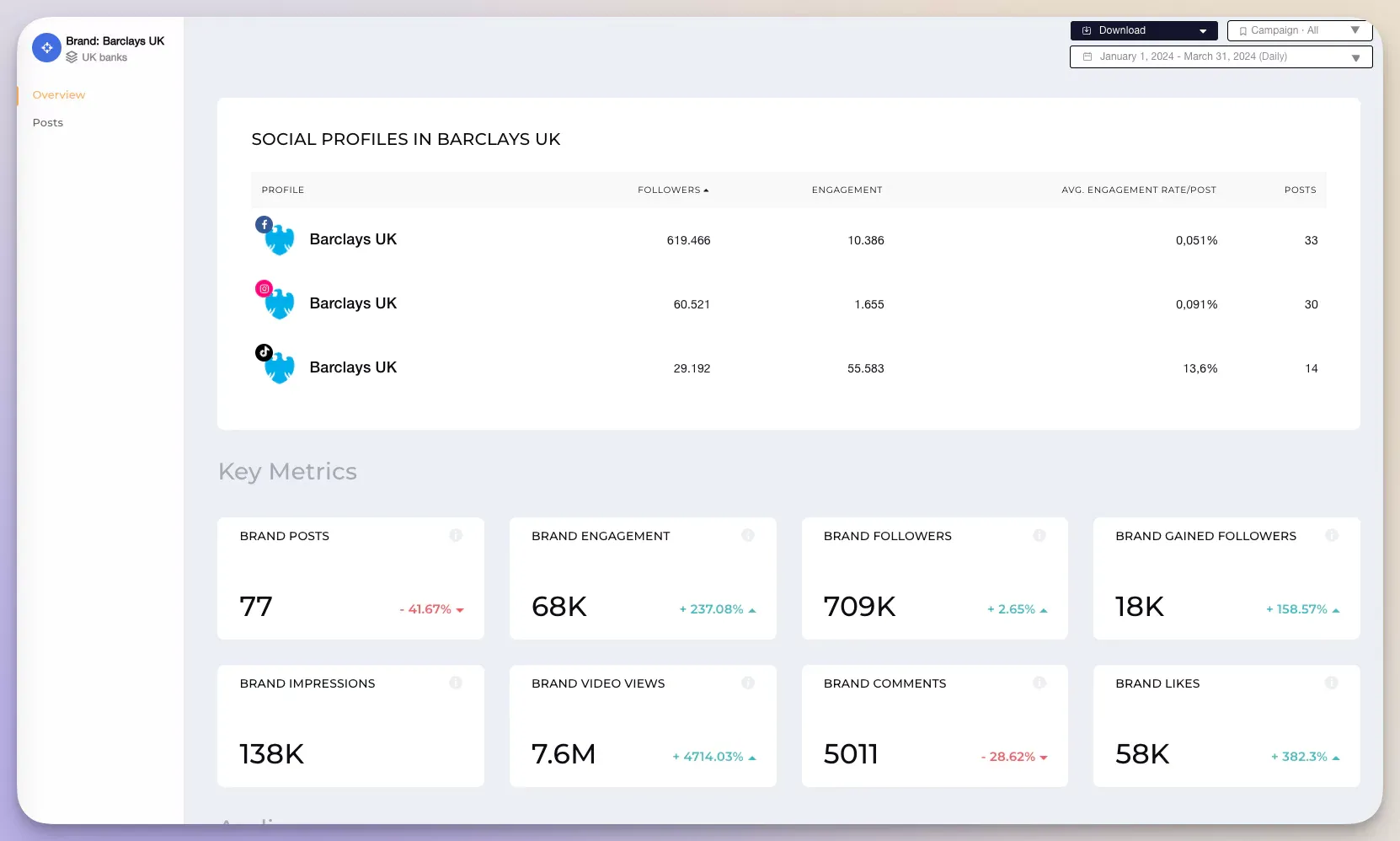
Don't wait for the year's end to discover that you didn't reach your goals or spread resources too thin.
Make sure you have regular reporting and content performance analysis to inform adjustments to your strategy. Always be willing to test and learn! - Nick Sylvia, Director, Global Social Media at Mastercard
Monitor KPIs monthly to see trends in performance, identify possible problems, and be proactive about solving them.
For example, a dip in engagement compared to previous months can point to a technical glitch, an issue with the content, or the targeting. A growth in followers and brand sentiment can signal that you're on the right track.
The important thing is not to do guesswork but to let numbers and facts guide your strategic decisions.
Optimize your social media strategy
You've done a great job creating a powerful social media strategy. But you're not done yet.
Besides seeing the strategy through, you must regularly tweak and adjust it to optimize your social media game.
But don't worry. When you go through the steps we described, you build a strong foundation on which you can keep building.
Here is what to do regularly:
- Keep an eye on social media analytics to understand what’s working and what’s not.
- Use learnings and insights to create actionable plans for improvement.
- Regularly brainstorm new content ideas with your team and other stakeholders.
- Stay updated with evolving social media trends.
- Refine the posting schedule based on your audience's behavior and platform insights.
- Adjust targeting based on observations.
- Experiment with new social media features.
- Partner with relevant influencers to reach a wider audience and gain more credibility.
- Monitor competitors and other brands to learn from great social media strategy examples.
Remember that data by itself is not useful. Leverage the right tools and expertise to transform data into actionable items for your business.
A strong strategy can't live in a silo - you need people who understand data and can utilize it to inform insights. - Jessica Spar, SVP, Head of Social Media + Influencer Marketing at KWT Global
Social media strategy template
Feeling a bit overwhelmed by all the information and steps you need to take? We’ve got your back with an insider’s document that will quickly position you as a marketing guru.
Because we know that starting from scratch is hard, we created a social media strategy template that will help you organize your all your information in one place. Use it as a social media marketing plan example, or create a copy and start filling it in with your brand’s information.
You can use it as an internal document to present to your team or to other stakeholders. Enrich it with visually appealing social media reports and insights about your brand, audience, and competitors, which you can generate with Socialinsider.
Here’s what you will find in this free social media strategy template:
- SMART social media goals
- Detailed social media audience profile
- Blueprint for a social media competitor analysis
- Steps for a social media audit
- Social media channels breakdown
- Social media content plan layout
- Outline for your social media strategy evaluation
Start editing this template and fill the blanks with your numbers.
Get your free social media strategy template!
Social media strategy mistakes
Now that you've learned all the things you should do to develop a social media strategy that drives traffic and ROI to your brand, time to ensure you don't misstep.
Top-tier social media experts chip in and tell us about the frequent mistakes people make when designing their strategy.
Spoiler alert:
Common mistakes in social media strategy include not setting clear goals, overlooking the target audience, and inconsistent posting.
Some managers also ignore analytics, focus too much on sales, and fail to adapt to trends. - Vahbiz Cooper, Digital Marketing Specialist at Demandbase
Oopsie #1. Not setting clear goals
One of the most common mistakes in social media strategy is jumping in without setting clear, measurable goals.
All too often, businesses want it all: increasing brand awareness, getting engagement, driving traffic to landing pages, and boosting sales. We see it in our client interactions, and we hear it from experts.
Not that having several objectives is a problem per se. But without specific objectives tied to the right KPIs and timeframes, it's hard to stay focused and measure success.
For me, one of the biggest mistakes I see social media managers make is lacking clear goals, especially when it comes to distinguishing between short-term and long-term objectives. - Erick Kamau, Digital Marketing Lead at Cedarclink
Don't get lost in the daily grind of posting without knowing if your efforts are actually making an impact.
Identify what you want to achieve and set SMART goals, as explained in step #5 of the guide above.
Oopsie #2. Ignoring the audience's needs
Social media isn't just about letting people know how cool you (or your products) are. It’s about finding meaningful ways to engage with your followers.
One big mistake is focusing solely on what you want to say without considering what your audience wants to hear. The result? You’re up on a pedestal preaching to an empty room (or one that scrolls on their phone, looking for something more interesting to pay attention to).
If your content doesn't resonate with your followers, you’ll struggle to achieve any of your objectives.
Putting too much emphasis on personal opinions or preferences instead of keeping in mind what the audience wants to hear from the brand - is a mistake highlighted by Social Media Strategist Danielle Olavario.
In addition, some brands pay more attention to competitors than their audience. While competitor analysis has its merits, imitation without strategy won't get you far.
Dave Trausneck, Communications & Marketing Executive, describes this common mistake:
Trying to position the brand as something it's not. Some social media managers see the success of other "darling" brands and try to copy something or a trend, rather than focus on what their audience wants.
To avoid this pitfall, take time to truly research and understand your audience's preferences and interests and use them as a basis for your social media strategy document. Jump to step #2 in the "9 steps to create an effective social media strategy" section above to get actionable tips on how to do this.
Oopsie #3. Neglecting the importance of posting frequency
Consistency in social media posting helps you stay top of mind with your audience. Brands that post irregularly risk getting lost in the noise.
On the other hand, posting too much, too often, can create too much noise and lead to unfollows.
Many social media managers can fall into the trap of inconsistent posting or overposting, ignoring audience insights and analytics, and failing to adapt to platform algorithm changes. - Essence Smith, Head of Social Media at Ascendion
To find the right balance, establish a content calendar that allows you to post regularly and create value.
Pay attention to your social media analytics and industry benchmarks to understand when your audience is most active and plan your posts accordingly.
Oopsie #4. Lacking an in-depth understanding of competitors
Simply Googling two or three competitors and quickly glancing over their social media pages does not provide sufficient insights to inform a social media strategy.
Unfortunately, that's what many brands call a competitor analysis. It's a frequent mistake and a missed opportunity.
Some of the most common mistakes I see many people make with social media strategy is incorrectly identifying our competitors.
Your competitors are not just within your industry.
Social Media is the battle of attention and inspiration can come from top performing brands that do not sell or service the same people but garner a lot of engagement on social media. - Denise Reid, Social Media and Creative Consultant
Businesses that fail to analyze the competitor landscape thoroughly risk falling behind or, worse, replicating tactics that don't work.
Conducting an in-depth competitor analysis is crucial, and you can learn how to go about it by clicking on step #4 in the sample social media plan above.
Oopsie #5. Not optimizing content for different platforms
Although experts keep advising businesses to tailor content considering different formats and audience preferences, many brands continue to copy and paste the same posts everywhere.
A significant misstep is assuming content can be uniformly applied across platforms, such as expecting what works on Insta to perform equally well on TikTok.
Each platform has a different strategic purpose, audience behaviours, and content preferences that must be considered. - Kineta Kelsall, Founder & Director School of Social
Adriana Castillo agrees:
One common mistake is not fully understanding or engaging with the audience or treating all social media platforms the same.
The reasons behind this mistake are plenty: lack of time, budget, or expertise for adaptation and personalization.
However, a one-size-fits-all approach to content simply doesn't get you optimal results.
Mariam Sow draws a great analogy between treating all platforms the same and posting identical content across the board with fashion:
That’s like wearing a tuxedo to the beach—wrong vibe, wrong place. Each platform has its own culture and audience, so content should be customized accordingly.
To avoid this pitfall, plan your resources to allow for content optimization. Publish less if you must, but ensure that your social media posts resonate with your audience and with the platform vibe.
Oopsie #6. Lack of actionable plans
Many brands do great in the initial phases, doing research, setting goals, and brainstorming content ideas — but then fail to take proper action.
You need to take the information you learn in your data collection and competitor analysis to create actionable ways to improve the social media presence. - Alex Haider, Social Media Specialist at Second Harvest Heartland
A good strategy should include a concrete plan for daily, weekly, or monthly tasks that are manageable and trackable. Translate research and ideas into a social media content calendar with roles and deadlines.
Also, great strategies are not set in stone. Track KPIs to draw insights and create actionable plans for continuous improvement.
Oopsie #7. Ignoring trends
To paraphrase Heidi Klum's catchphrase on the Project Runway reality show, in social media, one day you're in, and the next, you're out.
Brands that ignore trends can quickly become outdated, irrelevant, or boring.
No one says you should jump on every fashionable bandwagon, but you should keep an eye on trends and leverage the ones that align with your brand.
Social media is dynamic, so it's vital to leave flexibility in your content schedule to respond to trends or viral moments as they arise. - Ivy Mullins, Social Media Manager at Born Social
To avoid falling behind, analyze trending hashtags, popular topics, and viral content. Focus on content creators in your niche, but don't ignore other industries, as trends easily migrate.
Who knows, you might get your next big, creative idea simply by paying attention and having an open mind.
Oopsie #8. Not using data to optimize social media strategies
Would you drive a car blindfolded? Of course not.
Posting on social media without paying attention to analytics is a bit like driving without visibility. You have no idea where you're headed, if you need to course correct, or if you're even on the road (to achieving your goals). The eventual crash may be just virtual, but it can still hurt your business.
Paying attention to analytics is like turning the headlights on. Taking the blinds off. And finally seeing the map on your dashboard.
Monitoring performance through analytics is essential to understanding what's working and what needs adjustment, allowing for continuous optimization to keep the strategy aligned with the brand’s goals and drive impactful results. - Alma Pantaloukas, Founder + Lead Strategist, Ritual Thrive
Make it a habit to regularly review your analytics and adjust your strategy based on what the data tells you.
A common mistake is assuming that once something works in your strategy, it will always work. - Carmen Collins, Creative Social Media Marketing Executive
Experiment with different types of content, posting times, and messaging, and let the numbers guide your social media journey. Head over to step #9 in the example of a social media marketing plan above for more instructions.
Oopsie #9. Confusing strategy with tactics
Strategy and tactics are often mixed up. They are complementary but not the same. A strategy is your overall plan for achieving your goals, while tactics are the specific actions that help you get there.
The thing I see most often is confusing strategy with tactics. Using influencers isn't a strategy. Neither is trend-based content.
Those are tactics, that when used well can help achieve the goals you've outlined, but they're not your social media strategy. - Courtney Thomas, Director of Social Media at Aloysius Butler & Clark
Before diving into tactics like posting schedules or ad campaigns, make sure you have a well-defined digital marketing strategy in place.
It's easy to say you're going to be doing this form of creatives or testing out new platforms, but you need to illustrate how these tactics are part of your strategy. - Alvin Gulputh, Social Media Lead at Thredd
Your strategy should outline your goals, target audience, and content plan. All your tactics should stem from there to ensure coherence and efficiency.
Focus on tactics without strategy, and your efforts will be disjointed, often failing to produce consistent results or align with the business needs.
Who’s responsible for creating a social media strategy plan?
Creating a successful social media strategy is team effort, without a doubt.
As Nick Sylvia points out:
Developing a social strategy should fall on a combination of brand management, creative, data/insights, and social media management roles.
Each of these roles brings a unique perspective: brand management ensures that the strategy aligns with overall business goals, creative teams provide the content direction, and data experts ensure that decisions are based on analytics.
This collaborative effort should exist even on small teams.
If the team is small and there's only one social media manager in the company, they should develop the strategy in collaboration with the CMO. The person responsible for strategy development should have substantial experience in various areas and proven case studies with results over time. - Karina Oksa, Social Media Lead at Sumsub
Calvin Walker adds that if an organization doesn't have a dedicated social media team, the responsibility should fall under the marketing department.
In an ideal scenario, the social team is able to have conversations with other teams (ie: ecomm, product, etc.) to see what, if anything, feels relevant to the shaping of their strategy. Those other teams will also know the decision maker on what gets included and implemented comes down to the social team. - Calvin Walker, Social Media Consultant
On the other hand, specialization is also important for creating successful strategies.
Ideally you have either a dedicated person in your organization or you hire an agency. The most important if you have a dedicated person is for them to concentrate on just social media. - Ian Mason, Founder of Glimmer Marketing
As Courtney Thomas points out:
You often see a 'social media manager' or 'social media strategist' job title that's doing strategy while running channels, creating content, doing reporting and sometimes doing paid social. Those are, ideally, different jobs.
A specialized approach allows each team member to focus on what they do best, ensuring you optimize your social strategy’s creation and execution.
However, specialization doesn't change the fact that, in order to deliver great outcomes, social media managers must wear many hats.
Anyone in the social media management space or Digital Marketing should be in a position to deliver a good social media strategy.
Other than understanding the different social media platforms, they need to understand various aspects of content development and marketing, analytics, and how other activities in a business affect a brand, such as paid media, community management, customer service, etc.
They also need to conduct thorough research, understand their target audience, and stay updated with the latest social media trends and the usual platform updates. - Eric Kamau, Social Media Marketing Lead
To relieve some of the burden, social media managers should collaborate and coordinate with other roles on the team to ensure timely execution and quality output.
A social media strategist is responsible for creating the social media strategy while working along side the content creator specialist to execute the strategy. - Maria Olawumi, Senior Marketing Specilist
How often you should update your social media strategy
You should update your social media strategy periodically, based on concrete insights. The period depends on business needs and changes in the market.
We conducted a survey and the data shows that 55.6% of respondents update their strategy based on specific events or triggers, which could include changes in business goals, product launches, or trends.
For these businesses, flexibility is clearly important. This less structured approach can also be an indication of lack of consistent actionable insights and less planning around optimization.
However, many respondents follow a more structured approach, with 15.6% updating monthly, 15.6% quarterly, and 11.1% annually. These intervals allow for regular adjustments based on performance metrics, avoiding a stagnant state of social media affairs.
We recommend a combination of periodic reviews and event-based updates based on social media data, competitor analysis, and audience research to ensure that your strategy remains relevant and your business agile.
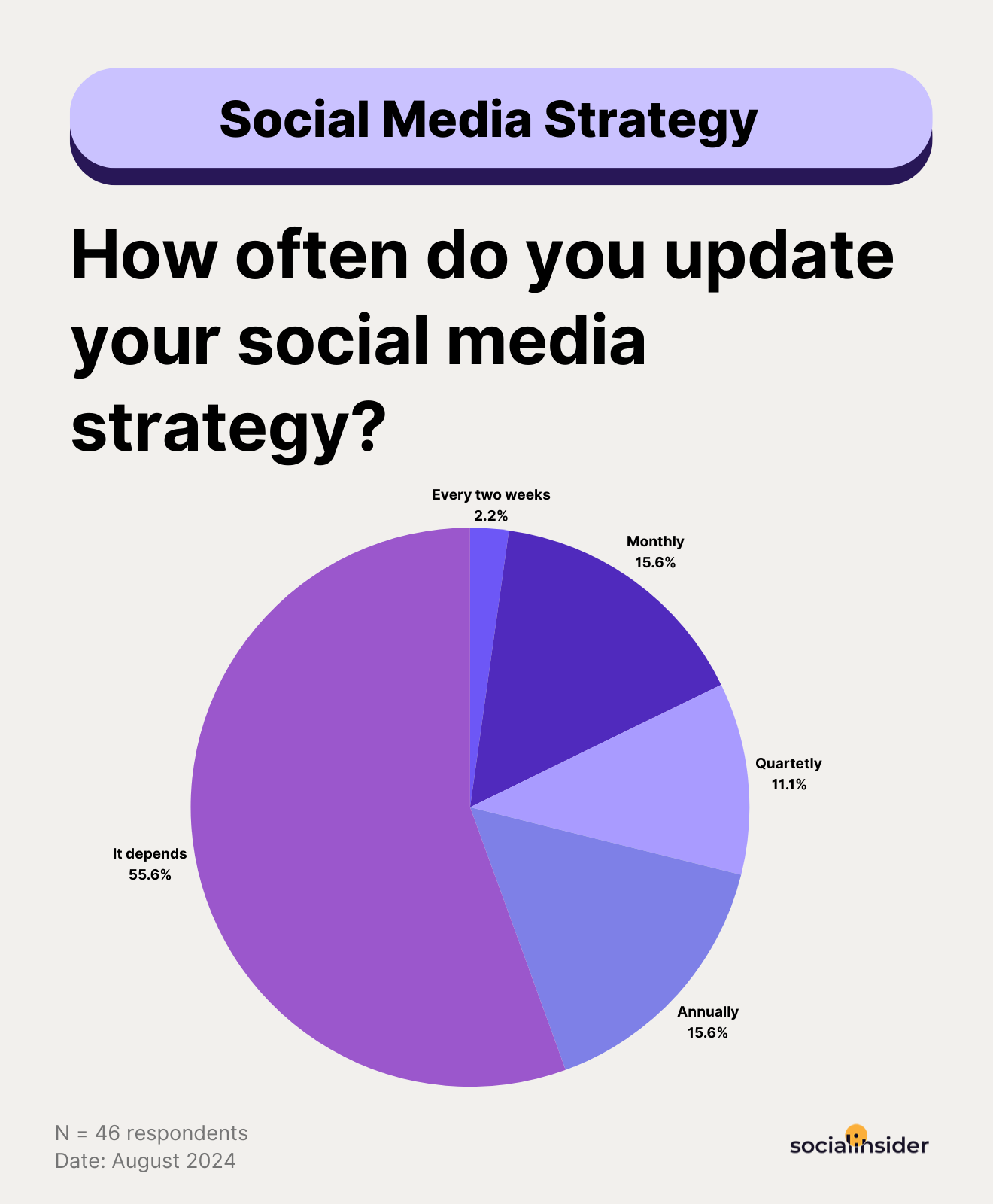
FAQs about social media strategy
Do I need a social media marketing strategy?
Definitely. A social media strategy outlines your goals, target audience, and tactics for using social platforms effectively. It helps build a solid online presence, better engage with your audience, and improve social media ROI.
What should be included in a social strategy?
A comprehensive social media marketing strategy includes goals, target audience research, platform selection, content calendar, engagement tactics, KPIs, and an optimization plan.
How can I measure the success of my social media strategy?
Social media analytics tools and the data available on social platforms help you understand performance. Track key metrics like reach, engagement, click-through rates, and follower growth. Analyze this data to see what's working and adapt your strategy for continuous improvement.
Which social media platforms should I be on?
There's no one-size-fits-all answer. It depends on your target audience and brand. Research where your ideal customers spend their time online and choose platforms that align with your content strategy.
How often should I post on social media?
Posting consistency is key, but the frequency can vary depending on the platform. Analyze your audience behavior and platform insights to identify optimal posting times and avoid overwhelming your followers.
Should I consider paid advertising as part of a social media strategy?
Yes, you should consider paid ads as part of your social media strategy. Paid campaigns can amplify your reach to specific demographics and drive measurable results. Analyze the cost-effectiveness, start small, and add budget as you understand what works.








